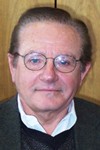AWRI hosts public discussion on controversial Great Lakes study

Gene Stakhiv, U.S. chairman of the International Upper Great Lakes Study
Aug 2, 2011
“The needs of the people, the basin, change,” began the U.S. chairman of the International Upper Great Lakes Study, Gene Stakhiv, during a public forum on July 30 at Grand Valley State University’s Annis Water Resources Institute in Muskegon, Mich.
The public meeting was the fifth stop of 12 total for the International Upper Great Lakes Study team, a joint venture between the U.S. and Canada to preserve and restore the region’s most prominent resource, the waters of the Great Lakes.
In explaining their findings, the team of scientists were met with some opposition when citizens called the research “incomplete” because of several outside factors that the team did not consider. Those outside factors included legal issues, commercial use of the lakes and the monetary implications of not only the study, but of the equipment Stakhiv said would be most beneficial to the lake system.
Initially launched in 2007, the five-year study focusing on the predictions of future water levels in the Great Lakes – more specifically Lake Superior and Lake Michigan-Huron – is nearing the end of its course. Stakhiv and the other members of the group conducting the study were hired by the International Joint Commission, under instruction only to observe and make no recommendations.
“We aren’t making recommendations,” Stakhiv said. “Our job is to examine the effectiveness of the structures already in place on the lake. We are not making suggestions for any changes.”
Stakhiv’s team submitted their report of the lakes for a peer review and expects the results before the end of October. Included in the report are several plans that the two governments could adopt to help keep our water both commercially and economically sound. The primary target of the study was to look into compressing the lake’s water levels to both reduce the overflow of water during wet seasons and reduce the amount of the water lost to evaporation during the dry seasons. However, Stakhiv said that nothing made by man has been able to permanently withstand Mother Nature.
“Mother Nature ultimately decides what happens,” he said. “Nothing we make can stop her.”
According to the study, the major problem is that the most economically beneficial compression of the water does the most damage ecologically. In addition to that damage, the structures that the study suggested would be beneficial in the lakes would rest in the area where lake sturgeon spawn, which could seriously impact the fish population. However, changing the position of the apparatus would make the project more costly because the process would require more structures to do the same amount of work.
Al Steinman, the director of AWRI, said that while some questions have been raised about the amount of money used for the study and the discussion of additional spending on controlling lake flow, the study did provide the area with additional measurement tools that will help scientists understand more fully what is happening in the water.
The study also focused on the movement of the Great Lakes Basin, a tectonic plate that moves at a rate of about 10 inches every century. The pivot point is a diagonal fault that cuts through the heart of the Lower Peninsula. As a result, the northeast region of the state will see drops in the water level of the lake as the land actually rises. This could cause the wetland areas to dry up and the commercial industries in the region to take a hit. Conversely, the southwestern portion of the state, including West Michigan, is sinking, making the future of the area more prone to flooding and the formation of swamp land more likely.
After the presentation, written comments and questions were solicited by Steinman and fielded by Stakhiv. Several comments suggested that the government would be better off if they left the lake as it is and allow nature to take its course. Stakhiv insisted that the work being done by the IJC is only beneficial to the lake.
“One of the conditions of the study is that we cannot leave the lake in a state that is worse than it would naturally be,” he said.
The study will have several more public meetings in the Great Lakes region, including some on the Canadian side of the lake. Stakhiv said that even if the report is adopted by the IJC, it could take several years to allocate money to implement a plan of action, meaning that any decisions made this year could be held off until the end of the decade.
_
[email protected]_

























